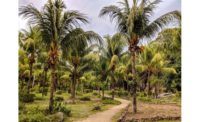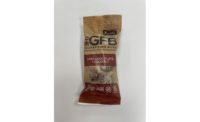
By Crystal Lindell
Associate Editor
Mike Constantine, CEO and President of Anastasia Confections, recently attended his first ECRM Show. The targeted conference is basically a string of one-on-one meetings between candy buyers and confectionery manufacturers. Companies such as Anastasia set up in a hotel room - minus the bed - while buyers circulate from room to room every 20 minutes.
It’s not cheap though. Manufacturers pay upwards of $15,000 to participate, so it’s important to make an impression.
And maybe it was because the Orlando-based company had home field advantage at the show - held at the Marriott World Center Resort in Orlando, Fla. - that they did just that: The company’s Coconut Patties Bar was among the top five scanned items by buyers at the event.
Not a bad first try.
Anastasia Confections clearly has a product people outside of its native Florida are interested in, and after recently moving into an 80,000-sq.-ft. plant, the company is well-positioned to take advantage of the attraction.
Constantine – who now runs the company with help from his wife Anastasia and his children, Dimitri, 26, and Katrina, 24 – first got into the candy business after buying a retail store in 1983. Soon, though, he started manufacturing products after noticing a glaring hole in the Florida confectionery market.
“With millions of tourists visiting Florida annually, I wanted to create a product line related to the tourist industry,” he explains. “My first products were chocolate and fudge alligators.”
Coconut patties soon followed and quickly outpaced the gators.
“In the beginning we started doing the original coconut patties at home and then in a very small warehouse,” Constantine says. “It took quite a few years to turn the corner and make it profitable and successful, but we did it little by little.”
The coconut products are still the most popular item, but the company also has since introduced a slew of Florida-themed treats, such as salt water taffy and jelly fruit squares. The sweets sell from anywhere between about $1 and $5.99.
Anastasia Confections also expanded on its popular line of coconut patties, which now come in six flavors, including: key lime, almond, orange, pina colada, mango and, of course, original.
“It feels good every time you create a new product,” he says.
And, you can find Anastasia Confections at every airport, hotel and gift shop in Florida.
“Our Coconut Patties have been a top seller for years in all of Florida’s airports,” Constantine says.
He credits the quality of the product and the appealing packaging - some of which feature a map of Florida, while others have palm trees, sea shells or gators - with enticing travelers to pick it up on their way back home.
“European visitors, traveling through the airports, don’t really know what a coconut patty is, but because of its attractive packaging, they’ll buy it as a Florida souvenir,” Constantine explains.
But what would a Florida tourism candy be without a presence in the state’s most famous theme park? And there too, Anastasia Confections has succeeded. The company manufactures a private label product for a major theme park in Orlando.
Anastasia Confections originally started at a manufacturing plant in Pompano Beach, which is in south Florida. Then, they moved to a 50,000-sq.-ft. facility in Orlando in 1997.
“[It was] a more centralized location. Because the bulk of the Florida visitors come to Orlando’s theme parks, we wanted to be in the heart of it,” he explains.
Outside of its home state, the company has expanded throughout the continental United States, and into Canada, and the Caribbean.
In fact, Anastasia Confections has been particularly successful with a Coco Rhumbies treat in the Caribbean.
“We use part of our coconut paste and then we add other ingredients, including real cocoa and vanilla wafer cookies [which are crushed]; so it’s a very tasty product,” Constantine says.
As for the company’s next stop on the map, Constantine says he doesn’t want to ship his confections too far because they have a limited shelf life, but he’s open to possibilities.
“We do have a customer in South Africa that took the coconut patties there,” he says. “They love the product, but transportation costs, duties and logistics make it difficult to sustain a profitable distribution.”
As for the specific retail carriers, Constantine says his biggest individual account excluding two key distributors, is Marmaxx, owners of T.J. Max and Marshalls and Home Goods. He’s also gotten the product into a number of drug stores, mass merchandisers, convenient stores and some supermarkets.
“We hope to expand on all these markets in the future,” he says.
The company also is looking to expand to Central American countries, where coconut is very popular.
“We’ve been doing this for 27 years and people keep buying it, so it has established its own recognition,” he says. “Our best advertisement is the product itself.”
Where it’s all made
But no matter where they ship to, it all starts out at the company’s new Orlando factory. The company moved there in 2009 from their 50,000-sq.-ft. facility, which has since been turned into a warehouse.
Constantine says the new factory, which smells like warm coconut, features fully state-of-the art processing and packaging automation.
Most of the equipment at the facility was purchased within the last five years, with well-known European and American suppliers installing the latest processing and packaging equipment.
To make the coconut patties, an operator starts with a liquid slurry (sugar, corn syrup and water), which is made in steam kettles and mixed with coconut and other ingredients in the RMF Paddle Mixers to create a coconut paste.
The paste is then extruded with a Reiser Vemags unit directly on to a 32-inch Nielsen (now part of Aasted ApS) enrobing line, which includes a chocolate melter, tempering machine, enrober and cooling tunnel.
Once the coconut patties are enrobed and cooled, they go through a series of Transver smart conveyors (Pull nose and Chicane systems) before being fed directly into a Bosch Doboy Linium 301 flow wrappers at a speed of 250 pieces per minute. The finished wrapped pieces then go through a Loma metal detector or a Thermo X-Ray detection machine.
A Kliklok ECT-625 carton former and a Vari-Right carton closer is used to pack and seal the final package while a Markem-Image laser coder burns the date code on the finished product. Final weights are verified using a hi-Speed Check Weigher.
“The whole line is totally automated,” Constantine says. “The product is not touched by hands.”
Off to the side of the main manufacturing area is a small room where they can make the company’s original chocolate alligators, dubbed, “the chocolate room.”
It features a Knobel one-shot depositor, an Aasted tempering unit, a Tinsley chocolate tank, and Savage chocolate melters.
The factory also has an on-site machine shop and storage in the back, as well as an office area up front.
The plant is not quite at capacity, but during winter months, the company runs extended hours with 1.5 shifts.
As for ingredients, most of the more than 400,000 lbs. of coconut used annually comes from the Philippines, Indonesia, Sir Lanka and Vietnam, by way of brokers.
The company also uses more than 400,000 lbs. of chocolate a year, which they get mainly through Cargill, Barry Callebaut and others; while the sugar, more than 300,000 lbs. annually, is sourced through local brokers.
Constantine says ingredient price increases have hit his company hard.
“It’s been tough,” he says. “In the last couple of years, commodities such as cocoa and sugar, along with coconut and everything else have gone up anywhere from 20% to 100%. These increases have reduced our profit margin considerably and to keep our prices competitive we cannot pass it on to the customers.”
Probably the hardest hit came from one of Anastasia’s main ingredients, coconut, which has doubled in price in the last couple years. Constantine explains the increase stems partly because of supply/demand issues, such as a greater demand for coconut oil, a growing demand for coconut water, typhoons in Philippines and fuel costs.
“We’re eating most of that cost,” he says.
Of course, Constantine says he wouldn’t consider sacrificing quality to make up the difference.
“Our model is to produce quality candy at a reasonable price. I would not make and sell anything that I would not give to my kids or my grandkids,” he says.
And he hopes the business itself will remain a legacy for his grandkids’ children.
“If you start something, like I did, I don’t want to sell it, I’d rather pass it on,” he says.
As long as Anastasia continues to create products that appeal across the board, there’s no doubt, it will generate smiles for several generations.
At a Glance
Anastasia Confections, Inc.
Headquarters: Orlando
Employees: 35 to 45
Plants: 80,000-sq.-ft processing plant in Orlando; additional 25,000-sq.-ft. warehouse.
2010 Sales: Candy Industry estimates $5 to $15 million.
Annual output: 2.5 million lbs. of candy annually.
Products: Coconut/chocolate-based confections, saltwater taffy, moulded chocolate products (Choc-o-Gators), enrobed chocolates, chocolate-covered pretzels and cookies, jelly citrus candies, and fudge. Rebagger of gummy and other novelty items.
Brands: Anastasia Confections, Tropical Confections
Management team:The Constantine family (Mike- President, Anastasia-v.p., Dimitri-v.p. operations, Katrina-accounting/office mgr.), Jose Do Nascimento-production mgr., James Lascano-sales mgr., Pablo Sanchez-maintenance mgr.




